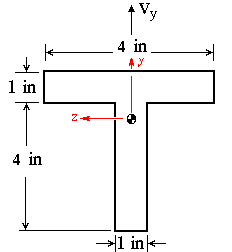

SOLUTION:
With the shear force along the y axis, the average flexural shear stress formula for the two components of interest is written as

Although the general form of the equation is the same for both components, there is a difference in the way Qz and t are found in each case. With Vy given, we proceed with the calculation of centroidal position.

The centroid is located at 3.25 in. from the bottom edge of the section. The moment of inertia about the z axis is found as

To calculate the tyx component of shear stress, the longitudinal surface has to have a normal in the y direction. The intersection of this longitudinal surface and the transverse surface is shown by a solid blue line in the figure below.
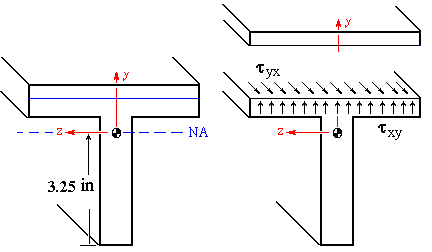
Depending on the position of the longitudinal surface along the y axis, the corresponding value for Qz is found as
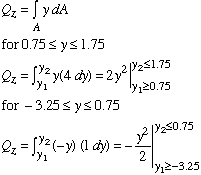
The equation for Qz is quadratic. Qzmax = 5.28 in3, and it occurs at the NA (y2 = 0). The variation of Qz is shown below.
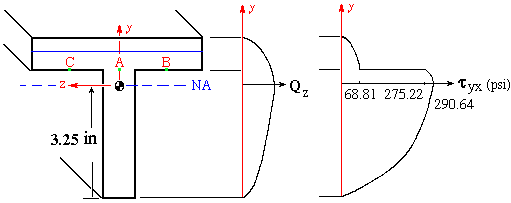
With the variation of Qz known, tyx is found as
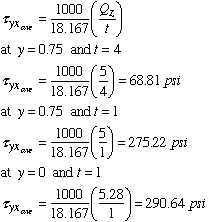
Keep in mind that t is the width of the longitudinal surface. Along -3.25 < y < 0.75, t = 1 in. and along 0.75 < y < 1.75, t = 4 in. As is shown in the figure above, there is a discontinuity in the shear stress at y = 0.75 in. due to the discontinuity in t. The maximum value of tyx is found to be 290.64 psi and it occurs at the NA. The values of tyx over the longitudinal surface are equal in magnitude to the corresponding txy values on the transverse surface.
It is crucial to pay attention to tyx variation at the junction. The value of 68.81 psi found in the analysis refers to the shear stress in the horizontal flanges just above the junction point. As there can be no shear stress on a free surface, the shear stress tyx and its counterpart txy are zero at points B and C but not at point A. As indicated by its plot, tyx is more significant in the vertical flange as opposed to horizontal flanges.
To calculate the tzx component of shear stress, the longitudinal surface has to have a normal in the z direction. The intersection of this longitudinal surface and the transverse surface is shown by a solid blue line in the figure below.
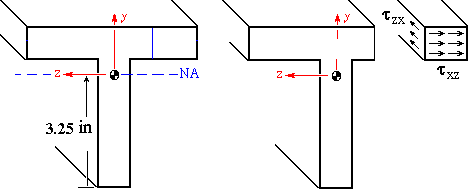
Depending on the position of the longitudinal surface along the z axis, the corresponding value for Qz is found as

The equation for Qz is linear in this case. At the section intersecting the corner of the horizontal and vertical flanges i.e., zz = +/-0.5, Qz = 1.875 in3. The variation of Qz is shown below.
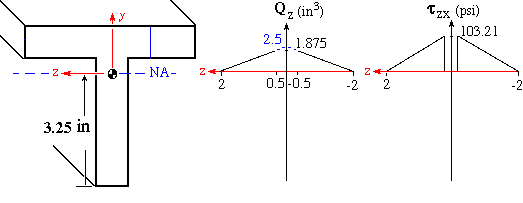
The blue dashed line gives the Qz variation at the junction of the horizontal and vertical flanges. This value is used to find the shear flow at that location.
With the variation of Qz known, tzx is found as
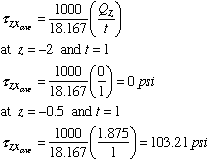
Keep in mind that t is the width of the longitudinal surface. Along -2 < z < -0.5, t = 1 in. As is shown in the figure above, tzx reaches its maximum value of 103.21 psi in the horizontal flanges at the junction with the vertical flange. In the vertical flange this component of shear stress is zero as shown below.
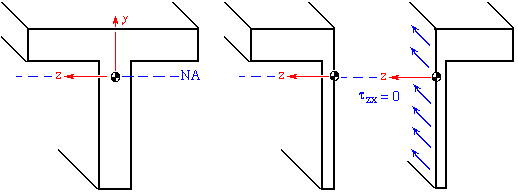
Notice that there is a counterpart shear stress (txz) on the transverse surface. Also in this case tzx is more significant in the horizontal flanges as opposed to the vertical flange.
key observation:
At any point on the boundary the resultant shear stress is parallel to the boundary. This fact helps us to sketch the figures shown below as a general depiction of shear flow and shear stress variations in this example.
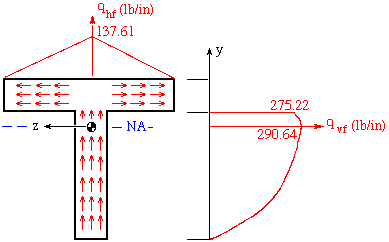
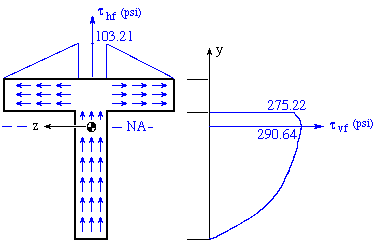
 To Section
III.3
To Section
III.3
 To Index Page of
Transverse Shear Loading of Open Sections
To Index Page of
Transverse Shear Loading of Open Sections